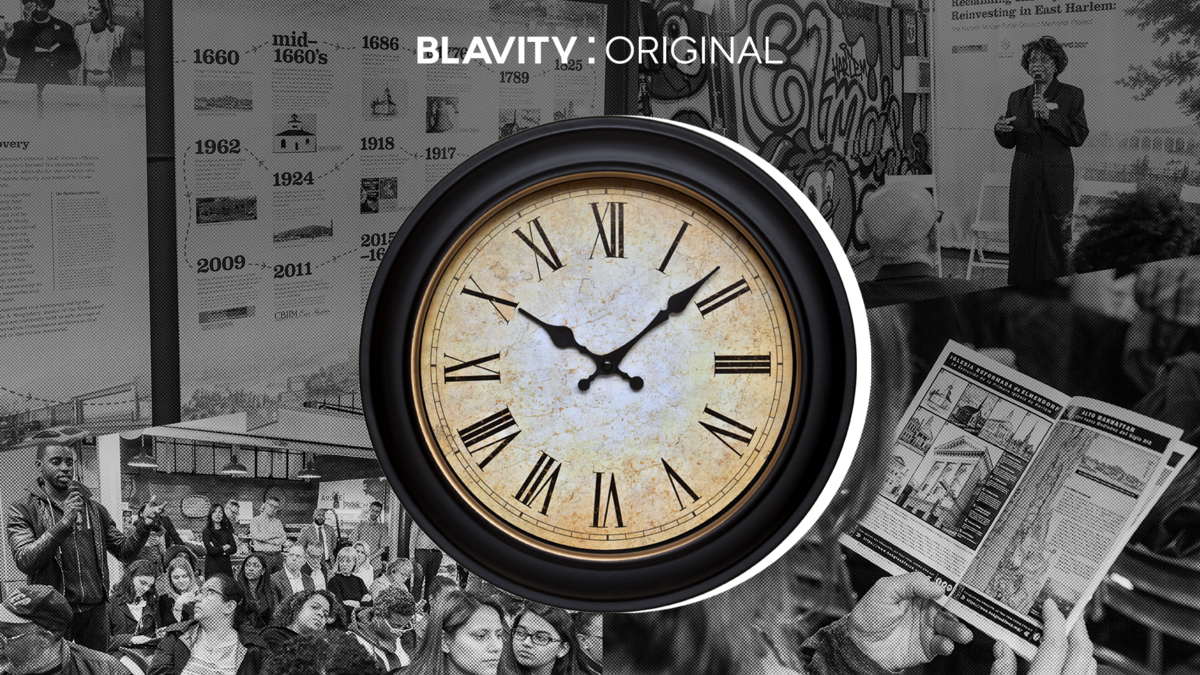An interesting thing about history is, no matter how deep it's buried it always manages to surface. No matter how close history comes to being forgotten, somehow the memory returns.Thankfully, Black history is as strong as 4C hair follicles and it ain't going nowhere, but there is still a lot to uncover. One of the latest stories rising to the surface is an ancient African burial ground, the first and only of its kind, discovered in New York City's East Harlem neighborhood.
The Harlem African Burial Ground is over three centuries old, as far as we know, and had been sitting under the 126th Street bus depot for 50 years — imagine that. Since 2009, a special task force has worked diligently to recover the site and honor the names who were buried beneath it. Today, the Harlem African Burial Ground (HABG) task force has partnered with the city, community and other stakeholders to share the colonial cemetery's story through a special exhibit and future educational memorial center.

The City of Harlem and Burial Ground History
Harlem has a special place in U.S. history. It's where Black cultural intellect experienced its acceptance in 1920s America. The city attracted some of the country's greatest icons from Zora Neale Hurston and Lena Horne to Malcom X and Langston Hughes. However, Black folks been adding to Harlem's rich culture and infrastructure, since the Dutch seized the land from its original settlers in the mid-1600s.
"Many people do not know about the contributions of free and enslaved Africans, in terms of building the infrastructure, culture and society of the burgeoning United States back in the 17th century and continuing," Manhattan deputy borough historian and HABG task force member Sharon Wilkins told Blavity.
Wilkins is an executive member of the task force and explained how a whole cemetery got buried underneath a New York City transportation center then rediscovered five decades later. The story begins in 1660 when the Low Dutch Reformed Church of Harlem, now the Elmendorf Reformed Church, created the grave site for African descendants who were building and maintaining colonial Harlem. Eventually that land and the all-white cemetery that neighbored it, known as "God's Acre," were sold. In 1863, European remains were removed and reinterred at the famous Woodlawn Cemetery in New York City's Bronx borough (where Madame C.J. Walker and other notable Black figures have been enshrined), but the African remains were left behind.
Over the years, the sacred land that once housed dearly departed African descendants became a casino, movie theater and ultimately a bus depot, among other establishments. It wasn't until the Metropolitan Transit Authority started a construction project in 2008 that the burial ground's history came back into social consciousness. On the task force's interactive website, people can transport themselves to pre-colonial Harlem and see the area develop from its native roots to what it has become today. The internet site offers a deeper dive into Harlem's history, all the while highlighting the HABG's presence.
"There can be no authentic telling of American history without recounting this history," Wilkins noted.
The HABG Exhibit and Future Memorial
In authentically telling American history, Wilkins and the task force — led by Elmendorf Church pastor, Reverend Dr. Patricia A. Singletary and New York City Council Speaker Melissa Mark-Viverito— have gathered almost a decade of painstaking research. Their collaboration with the city and community has resulted in digs that uncovered disjointed remains from three people and investigations revealing close to 50 names from church burial archives.
On May 16, the team showcased their research and details about the future of the HABG in an intriguing mini exhibit hosted at the La Marqueta Market in East Harlem. The free HABG traveling exhibit will remain at La Marqueta until the end of September. Wilkins and the city encouraged community members to catch the display, while it's available.


“We think this is a really great opportunity to pay homage to an erased history and forgotten community, and reconcile that fact to the extent that people are able to learn more about this particular site’s incredible history and the surrounding East Harlem community," Erich Bilal, the New York City Economic Development Corporation (NYCEDC) assistant vice president of development shared. "We’re now focusing our efforts on ensuring that this community-driven, robust planning process paves the way for the permanent memorial and cultural center.”
As for the future of the HABG, the task force and city are in the middle of an extensive planning period that should result in a grand memorial and educational center. In addition to informing the community and honoring the people who are buried beneath the soil, the future center aims to provide local residents with job and housing resources.They even plan to reinter the recovered ancient remains in the memorial building. When completed the construction will house stories that add to the cultural landscape of America and increase Harlem's footprint in Black history.
When it comes to uncovering the past, it seems the task force is doing the hard part. All that's left for us to do is embrace the knowledge, share the stories and carry the pride that comes from our past into the future.
"Just becoming aware of the history is important, " Wilkins ended.
